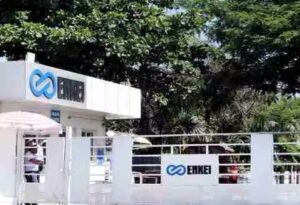1. At a Glance
Picture this: ₹40,938 crore of market cap lounging comfortably in Bengaluru, with skyscrapers, leased desks, and GCCs (Global Captive Centers) paying rent religiously. Embassy Office Parks REIT – India’s first and largest REIT – just dropped a Q2FY26 show that looks like a mix of “Corporate Jubilee” and “Debt Refinancing Rave Night.”
At ₹432 a unit, the REIT has given 11.8% return in 3 months, proving office real estate isn’t quite dead — it’s just sipping espresso while collecting rent. The quarter sawrevenue of ₹1,124 croreandPAT of ₹232 crore, even as the trust declared a juicy₹617 crore distribution (₹6.51 per unit)to unitholders. Occupancy hit93%, while1.5 million sq ftwas newly leased — the office version of a blockbuster quarter.
Debt? Oh, that’s flexing too: ₹2,000 crore NCDs raised in style, ratedAAA/Stableby both CRISIL and CARE. Net debt stands at ₹21,072 crore, but hey, when you have tenants like JP Morgan, Google, and Lowe’s, the rent cheques can handle it.
WithROE at 7.05%and anEV/EBITDA of 20.6x, Embassy Office Parks REIT continues to prove that Indian commercial real estate can be as liquid as a cold brew — if packaged well enough.
2. Introduction – The Corporate Landlord of India
Embassy Office Parks REIT isn’t your typical landlord. It’s like that one sophisticated uncle who owns half of Bengaluru’s skyline, collects rent in crores, and still complains about low yields on his FDs.
AsIndia’s first listed REITandAsia’s largest by area, Embassy has rewritten the rules of how real estate can be a public market product. Instead of buying one apartment and praying for a tenant who won’t break the geyser, investors can now own a piece of a ₹47,000 crore property empire — and get quarterly rent in the form of distributions.
The REIT owns45.4 million sq. ft.of commercial real estate — mostly glass-and-steel Grade-A office spaces, hotels, and even a solar park. About35.8 msfis already completed and84–93% occupied, with6.9 msf under constructionand another2.8 msfin the development pipeline. Bengaluru alone contributes72% of the portfolio value, followed by Mumbai, Pune, and NCR.
This is not a “build-and-sell” game — this is “build, lease, collect rent, repeat.” That steady cash flow allows the REIT to distribute90% of its incometo unitholders, as per SEBI’s REIT regulations. And that’s how investors get the real estate experience — minus the broker calls, legal disputes, and builder tantrums.
3. Business Model – WTF Do They Even Do?
Embassy REIT’s business model is elegantly simple:buy commercial office assets → lease them to multinational tenants → collect rent → distribute cash to investors.
Think of it as India’s corporate version of an Airbnb — but instead of tourists, you get CEOs; instead of weekend bookings, you get 10-year leases; and instead of cleaning fees, you collect escalations of10–15% every 3–5 years.
The revenue pie looks something like this:
- ~90%from office rentals
- ~7%from hospitality (Embassy’s hotels have 1,096 operational keys and 518 more under development)
- ~3%from renewable power (the 100 MW Bellary solar park, because even REITs need ESG points)
Tenants? Embassy’s halls are basically a roll call of Fortune 500 regulars —JP Morgan (6.4%),NTT Data (3.2%),Google,DBS, andEli Lilly.
And if you’re wondering how sticky this business is, consider this: 80% of the leases are with GCCs — companies that run captive centers in India and aren’t going anywhere. Embassy’s leases have built-in rent escalations, giving it the inflation-proof superpower most landlords can only dream of.
4. Financials Overview
| Metric (₹ Cr) | Latest Qtr (Q2FY26) | YoY Qtr (Q2FY25) | Prev Qtr (Q1FY26) | YoY % | QoQ % |
|---|---|---|---|---|---|
| Revenue | 1,124 | 997 | 1,060 | 12.7% | 6.0% |
| EBITDA | 868 | 774 | 821 | 12.1% | 5.7% |
| PAT | 232 | 158 | 155 | 46.8% | 49.6% |
| EPS (₹) | 2.45 | 1.67 | 1.64 | 46.7% | 49.4% |
Commentary:That’s not bad for a real estate landlord. Revenue grew12.7% YoY, EBITDA margin stayed flexed at77%, and PAT almost doubled QoQ. Embassy’s financials read like a well-behaved balance sheet: stable growth, stable occupancy, and a stable refusal to be dramatic.
5. Valuation Discussion – Fair Value Range Only
Let’s crunch like REIT nerds:
(a) P/E Method:
- EPS (TTM): ₹3.19
- Industry P/E: 57.8
- Current P/E: 135x
If Embassy were valued closer to the industry median (say 60x), its “fair value” range would hover around ₹190–₹250. But remember — REIT earnings include heavy depreciation; true value lies in cash flow yield, not EPS alone.
(b) EV/EBITDA Method:
- EV: ₹61,158 Cr
- EBITDA (TTM): ₹2,773 Cr
- EV/EBITDA = 22x (current)Fair range for Indian REITs: 18–22x → Fair EV = ₹49,914–₹61,006 Cr → Fair unit price range: ₹395–₹450.
(c) DCF (Simplified Cash Flow Yield):Assume annualized cash flow = ₹6,170 Cr distribution × 4 = ₹24,680 Cr gross potential; discount at 9–10%. The implied NAV-based range aligns roughly around ₹420–₹460 per unit.
🧾Disclaimer:This fair value range is for educational purposes only and isnotinvestment advice.
6. What’s Cooking – News, Triggers, Drama
Oh, plenty. The Q2FY26 party was eventful:
- Embassy declared a₹617 crore distribution (₹6.51/unit), keeping up its reputation as a “quarterly rent machine.”
- Occupancy surged to93%, a big jump from 84% a year ago.
- The REIT raised a₹2,000 crore 10-year NCDat7.33%, proving investors still trust it more than some midcap NBFCs.
- Ratings reaffirmed:CRISIL

















